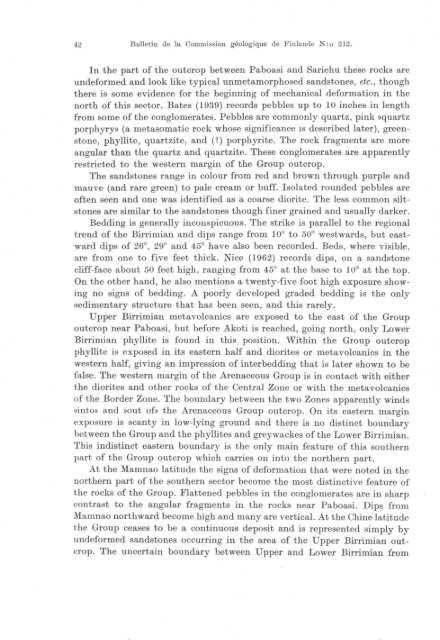COMMISSION GEOLOGIOUE - Arkisto.gsf.fi
COMMISSION GEOLOGIOUE - Arkisto.gsf.fi
COMMISSION GEOLOGIOUE - Arkisto.gsf.fi
Create successful ePaper yourself
Turn your PDF publications into a flip-book with our unique Google optimized e-Paper software.
42 Bulletin de Ia Commission geologique de Finlande N: 0 212.<br />
In the part of the outcrop between Paboasi and Sariehu these rocks are<br />
undeformed and look like typical unmetamorphosed sandstones, etc., though<br />
there is some evidence for the beginning of mechanical deformation in the<br />
north of this sector. Bates (1939) re cords pebbles up to 10 inches in length<br />
from some of the conglomerates. Pebbles are commonly quartz, pink »quartz<br />
porphyry» (a metasomatic rock whose signi<strong>fi</strong>cance lS described later), greenstone,<br />
phyllite, quartzite, and (1) porphyrite. The rock fragments are more<br />
angular than the quartz and quartzite. These conglomerates are apparently<br />
restricted to the western margin of the Group outcrop.<br />
The sands tones range in colour from red and brown through purpie and<br />
mauve (and rare green) to pale cream or buffo Isolated rounded pebbles are<br />
often seen and one was identi<strong>fi</strong>ed as a coarse diorite. The less common siltstones<br />
are similar to the sandstones though <strong>fi</strong>ner grained and usually darker.<br />
Bedding is generally inconspicuous. The strike is parallel to the regional<br />
trend of the Birrimian and dips range from 10° to 50° westwards, but eastward<br />
dips of 26°, 29° and 45° have also been recorded. Beds, where visible,<br />
are from one to <strong>fi</strong>ve feet thick. Nice (1962) re cords dips, on a sandstone<br />
cliff-face about 50 feet high, ranging from 45° at the base to 10° at the top.<br />
On the other hand, he also mentions a twenty-<strong>fi</strong>ve foot high exposure showing<br />
no signs of bedding. A poorly developed graded bedding is the only<br />
sedimentary structure that has been seen, and this rarely.<br />
Upper Birrimian metavolcanics are exposed to the east of the Group<br />
outcrop near Paboasi, but before Akoti is reached, going north, only Lower<br />
Birrimian phyllite is found in this position. Within the Group outcrop<br />
phyllite is exposed in its eastern half and diorites or metavolcanics in the<br />
western half, giving an impression of interbedding that is later shown to be<br />
false. The western margin of the Arenaceous Group is in contact with either<br />
the diorites and other rocks of the Central Zone or with the metavolcanics<br />
of the Border Zone. The boundary between the two Zones apparently winds<br />
»into» and »out of» the Arenaceous Group outcrop. On its eastern margin<br />
exposure is scanty in low-lying ground and there is no distinct boundary<br />
between the Group and the phyllites and greywackes of the Lower Birrimian.<br />
This indistinct eastern boundary is the only main feature of this southern<br />
part of the Group outcrop which carries on into the northern part.<br />
At the Mamnao latitude the signs of deformation that were noted in the<br />
northern part of the southern sector become the most distinctive feature of<br />
the rocks of the Group. Flattened pebbles in the conglomerates are in sharp<br />
contrast to the angular fragments in the rocks near Paboasi. Dips from<br />
Mamnao northward become high and many are vertical. At the Chine latitude<br />
the Group ceases to be a continuous deposit and is represented simply by<br />
undeformed sandstones occurring in the area of the Upper Birrimian outcrop.<br />
The uncertain boundary between Upper and Lower Birrimian from
















